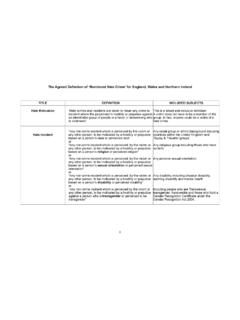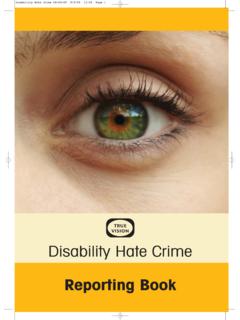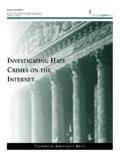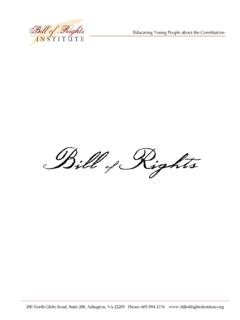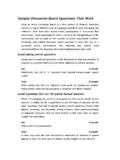Transcription of Hate Crime, England and Wales, 2015/16 - True …
1 Hate crime , England and wales , 2015 /16 Hannah Corcoran and Kevin Smith Statistical Bulletin 11/16 13 October 2016 i Important information In accordance with the Statistics and Registration Service Act 2007, statistics based on police recorded crime data have been assessed against the Code of Practice for Official Statistics and found not to meet the required standard for designation as National Statistics. The full assessment report can be found on the UK Statistics Authority website. Alongside the crime in England and wales , Year Ending March 2015 release, the Office for National Statistics (ONS) published a progress update on actions taken in addressing the requirements set out by the Authority. Further information is provided in the Hate Crimes Data Quality section (Annex B). For further information about police recorded crime statistics, please email: or write to: crime and Policing Statistics, 1st Floor Peel Building, 2 Marsham Street, London, SW1P 4DF Home Office Responsible Statistician Damon Wingfield, Head of crime and Policing Statistics Contact via This statistical bulletin is produced to the highest professional standards and is free from political interference.
2 It has been produced by statisticians working in the Home Office crime and Policing Analysis Unit. It has been produced in accordance with the Home Office s statement of compliance with the Code of Practice for Official Statistics, which covers Home Office policy on revisions and other matters. The Chief Statistician, as Head of Profession, reports to the National Statistician with respect to all professional statistical matters and oversees all Home Office Official Statistics products with respect to the Code, being responsible for their timing, content and methodology. ii Contents Page Conventions used in figures and tables .. iii List of figures and tables .. iv Key points .. 1 1 Introduction .. 2 Overview .. 2 2 Police recorded hate crime .. 4 Prevalence and trends .. 4 Hate crimes by type of offence.
3 8 Hate crime outcomes .. 10 Transferred or cancelled 14 3 Racist Incidents .. 16 Annex A Hate crime and the EU Referendum .. 17 Annex B Hate crime data sources and quality .. 21 Introduction .. 21 Police recorded crime data sources and validation process .. 21 Further Information .. 23 iii Conventions used in figures and tables Table abbreviations 0 indicates no response in that particular category or less than (this does not apply when percentages are presented to one decimal point). - indicates that for police recorded crime percentage changes are not reported because the base number of offences is less than 50.. indicates that for police recorded crime that data are not available. Percentages Row or column percentages may not add to 100% due to rounding. A percentage may be quoted in the text for a single category that is identifiable in the tables only by summing two or more component percentages.
4 In order to avoid rounding errors, the percentage has been recalculated for the single category and therefore may differ by one percentage point from the sum of the percentages derived from the tables. iv List of tables and figures 1 Introduction .. 2 Table 1 The five racially or religiously aggravated offences and their non-aggravated equivalents .. 3 2 Police recorded hate crime .. 4 Table 2 Hate crimes recorded by the police by monitored strand, 2011/12 to 2015 /16 .. 4 Figure Number of racially or religiously aggravated offences recorded by the police by month, April 2013 to March 2016 .. 6 Figure Indexed trends in the number of assaults with/without injury, public fear, alarm or distress (racially or religiously aggravated and non-aggravated equivalents) offences, April 2013 to March 2016.
5 7 Figure Distribution of offences flagged as hate crimes, 2015 /16 .. 8 Figure Breakdown of hate crimes and overall recorded crime by selected offence types, 2015 /16 .. 9 Figure Breakdown of hate crime by selected offence types and monitored strand, 2015 /16 .. 10 Figure Percentage of racially or religiously aggravated offences and their non-aggravated equivalents recorded in 2015 /16 resulting in charge/summons, by offence type .. 11 Figure Percentage of selected offences dealt with by a charge/summons, offences recorded in 2015 /16, 24 forces .. 13 Figure Percentage of selected offences resulting in charge/summons, by strand, offences recorded in 2015 /16, 24 forces .. 13 Figure Median number of days taken to assign an outcome, hate crime flagged and non-hate crime flagged offences, offences recorded in 2015 /16, 24 forces.
6 14 3 Racist incidents .. 16 Figure Number of racist incidents recorded by the police (excluding British Transport Police), England and wales , 2009/10 to 2015 /16 .. 16 Annex A Hate crime and the EU Referendum .. 17 Figure A1 Number of racially or religiously aggravated offences recorded by the police, 2013 to 2016 .. 18 Figure A2 Indexed trends in the number of racially or religiously aggravated offences and their non-aggravated equivalents recorded by the police, April 2014 to August 2016 .. 19 Figure A3 Number of racially or religiously aggravated offences recorded by the police, 31 forces, May to Aug 2016 .. 20 1 Key points Police recorded crime In 2015 /16, there were 62,518 offences recorded by the police in which one or more hate crime strands were deemed to be a motivating factor.
7 This was an increase of 19 per cent compared with the 52,4651 hate crimes recorded in 2014/15. The number of hate crime offences in 2015 /16 for the five centrally monitored strands were as follows: 49,419 (79%) were race hate crimes; 7,194 (12%) were sexual orientation hate crimes; 4,400 (7%) were religious hate crimes; 3,629 (6%) were disability hate crimes; and 858 (1%) were transgender hate crimes. It is possible for a hate crime offence to have more than one motivating factor which is why the above numbers sum to more than 62,518 and 100 per cent. There were increases in offences recorded for all five of the monitored hate crime strands between 2014/15 and 2015 /16. As stated by the Office for National Statistics (ONS), action taken by police forces to improve their compliance with the National crime Recording Standard (NCRS) has led to improved recording of crime over the last year, especially for violence against the person offences.
8 Together with a greater awareness of hate crime , and improved willingness of victims to come forward, this is likely to be a factor in the increase in hate crimes recorded by the police in 2015 /16 compared with the previous year. As this publication covers hate crimes recorded by the police between 1 April 2015 and 31 March 2016, the number of offences will not be affected by any increase in hate crime following the EU Referendum which took place on 23 June 2016. However, an Annex is provided in this publication, which examines levels of hate crime (specifically racially or religiously aggravated offences) around the EU Referendum. There was a sharp increase in the number of racially or religiously aggravated offences recorded by the police following the EU Referendum. The number of racially or religiously aggravated offences recorded by the police in July 2016 was 41% higher than in July 2015 .
9 1 Figure differs to that previously published (52,528) due to small changes in the volume of crimes identified by forces as hate crimes. 2 1 Introduction OVERVIEW This publication provides information on the number of hate crimes recorded by the police in England and wales in 2015 /16. Additionally, information on levels of hate crime around the time of the EU Referendum which took place on the 23 June 2016 is presented in Annex A. This includes data that have not been reconciled with police forces. Additional information on the number of hate crimes reported by respondents to the crime Survey for England and wales (CSEW) was last published in Hate crime , England and wales , 2014/15 for combined survey years 2012/13, 2013/14 and 2014/15.
10 Due to the low volume of hate crime incidents in the sample survey, the figures are not sufficiently robust to report for a single year of the CSEW. The analysis has not been updated this year to avoid an overlap in the years included in the three-year dataset. Hate crimes recorded by the police Hate crime is defined as any criminal offence which is perceived, by the victim or any other person, to be motivated by hostility or prejudice towards someone based on a personal characteristic. This common definition was agreed in 2007 by the police, Crown Prosecution Service, Prison Service (now the National Offender Management Service) and other agencies that make up the criminal justice system. There are five centrally monitored strands of hate crime : race or ethnicity; religion or beliefs; sexual orientation; disability; and transgender identity.
